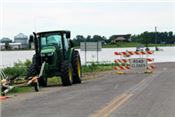|
Continued Flooding Keeps NW Mo. Farmland Underwater

University of Missouri Extension agronomist Wayne Flanary, left, and longtime area farmer Morris Heitman stand in front
of flooded land that could not be planted this year. Overall, Missouri ranked fourth in the nation in prevented-planting
acres in 2019.
Photo by Linda Geist
CRAIG, MO.
Morris Heitman knows the risk of flood and farming river bottomland. His family farmed there for more than 140 years.
Flooding that began March 16 remains. Floodwaters stayed longer than they did in 1984, 1993, 2010 and 2011, Heitman says. There is no end in sight.
It is harvest time and there are no crops to harvest. The Missouri River, which remains 6 feet over flood stage, covers most of Heitman’s farmland.
He says 60,000 acres of land in Holt County flooded this spring. He can’t recall a year when crops went unplanted. This is that year for many.
Things do not bode well for 2020 either. University of Missouri Extension agricultural engineering specialist Jim Crawford says there is a 50-50 chance to plant on bottomland next year. Dams in North Dakota and South Dakota remain full, and elevated river levels in Missouri will continue through December.
Traveling between work and home has become a struggle for northwestern Missouri residents. As waters started to recede, rain returned the first week of October, and the U.S. Army Corps of Engineers continued to release northern floodwaters.
Sections of key roads and highways remain closed. Floodwaters ebbed and flowed all summer. Some residents had to leave their homes several times to avoid being stranded.
“We are still nervous and will be for a couple of years,” Crawford says.
Farmland remains in peril because repairing levees takes time and requires cooperation among multiple agencies. Crawford says workers closed the northern breach in late August and water receded some in the northern half of Holt County. It may be next year before workers can plug levees in the county’s southern end.
Current repairs will allow levees to protect against 25-year floods. Restoring levees to withstand 100-year floods will wait until at least spring 2020, depending on the weather.
Atchison County farmers reported 55,971 prevented-planting acres to USDA’s Farm Service Agency. This represents 18 percent of the county’s cropland. Holt County farmers reported about 60,000 prevented-planting acres. Overall, Missouri ranked fourth in the nation in prevented-planting acres, according to FSA.
At the peak of flooding, water covered 85,000 acres in Atchison County. Crawford estimates about 30,000 of those acres are still underwater. “It has been and will continue to be a long process,” he says.
Damage appears to be worse and longer-lasting compared to previous floods, says MU Extension agronomist Wayne Flanary. Sand and debris need to be removed before planting can begin next year.
Flanary offers moral support for now, but his real work begins when farmers seek research-based guidance on nutrient management and crop management. Likely topics include fallow field syndrome, soybean inoculants and tilling methods.
In 2011, the National Oceanic and Atmospheric Administration was able to alert residents two weeks ahead of flooding. Flanary says area property owners received one day’s notice this year when levees broke and water gushed.
Emergency officials ordered the town’s 250 residents to evacuate after May rains. “It went into Craig like it was going for lunch,” Heitman says.
Farmers scrambled to move livestock and equipment to higher ground. They hauled grain stored in bins as fast as they could find trucks and laborers.
Some farmers, like brothers David and Eddie Drewes, had to choose between saving livestock or machinery. Their sons moved animals through mud to higher ground while the dads made makeshift levees and piled sandbags around grain bins. On March 16, as floodwaters rose, David had to evacuate the family to safety on a sprayer.
A neighbor of the Drewes, Welton Haer, a Korean War veteran, stayed in a local motel to avoid entrapment. He moved back when he thought it was safe. Floodwaters from early October rains then surrounded his home.
Heitman’s land lies in Holt County where the Mill Creek and Big Tarkio levees broke. Mill Creek and the Big Tarkio River are Missouri River tributaries. The Mill Creek breach was 81 feet deep; the one at Big Tarkio was 51 feet. The scour hole was nearly 28 acres.
In Holt County, a mishmash of 17 individual levee districts makes securing funds for repairs complicated and time-consuming.
The Federal Emergency Management Agency, the Army Corps of Engineers, the state of Missouri and the USDA Natural Resources Conservation Service all work to repair levees.
“We're trying to dance with four different agencies,” Heitman said. “All these agencies have their own requirements and parameters, and we're trying to coordinate those to build a secure system against the river.”
Repairs mean protection as well as relief from high crop insurance rates.
“Earthen levees are not built to withstand three months of water,” he said. Even after temporary repairs, seep waters strip nitrogen from the soil.
A nonstop caravan of trucks hauls rocks to fortify levees, railroad embankments and roads. The town bustles with construction workers while farmers reluctantly sit idle at the coffee shop and wait for next year.
Once a hot topic, the flood rarely gets mentioned, Heitman says. “It’s the 800-pound gorilla in the room that no one wants to talk about.”
Until floodwaters recede, the full extent of Mother Nature’s damage will remain unknown. It is a game of wait-and-see for resilient farmers with a can-do spirit.
“The frustration is that people want to do something,” Heitman says. “You can’t do anything. You just wait and get out of the way. Things work out. They always have.” ∆

Holt County farmers continue to face high waters from Missouri River flooding. This June 2019
photo show grain bins and equipment surrounded by floodwaters.
Photos by Linda Geist

Farmers along the Missouri River in Holt County traveled by tractor, boat, sprayer or any available means
to get to and from their homes. Longtime area farmer Morris Heitman says some families moved in
and out of their homes three times since flooding began in early 2019 to avoid being trapped in their homes.
|
|